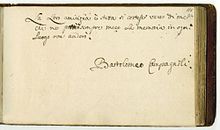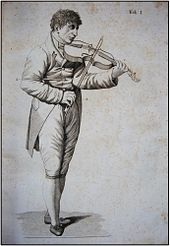Bartolomeo Campagnoli
Bartolomeo Campagnoli (born September 10, 1751 in Cento (Emilia-Romagna) , † November 6, 1827 in Neustrelitz ) was an Italian violinist , concertmaster and classical composer .
Life
Bartolomeo Campagnoli received his first violin lessons from his great-uncle, then from Alberto dall'Occa , a student of Antonio Lolli . From 1763 he studied in Modena with Don Paolo Gustarobba , a student of Tartini . Campagnoli received a position in the orchestra in his hometown in 1764. Enthusiastic about the playing of the violinist Franz Lamotte at a concert in Cento, he followed him to Venice and Padua in 1768. In 1770 Campagnoli gave successful concerts in Rome and Faenza. When he was already enjoying considerable success as a soloist, he settled in Florence and became a student of Pietro Nardini , who had a decisive influence on him. After a job at the Teatro Argentina in Rome, he got a job with the Prince-Bishop of Freising in 1776 . In 1787 he undertook concert tours through Germany, Poland and Scandinavia. In Stockholm he became a full member of the Royal Swedish Music Academy.
Then Campagnoli was in the service of various German royal houses, for example in 1797 with the Duke of Courland, before he was engaged as concertmaster in the Leipzig Gewandhaus Orchestra after his death in 1797 . From 1808 he was part of the original line- up of the Gewandhaus Quartet . He held both positions until 1816. In Leipzig he was admitted to the Freemason Lodge Minerva on December 6, 1808 to the three palms . In 1801 he traveled to Paris and made the acquaintance of Rodolphe Kreutzer , whose game impressed him very much. In 1816 he stayed in Italy for training purposes with his two daughters, who were singers, and on their return they were given jobs at the Frankfurt Opera. During his time in Leipzig, Campagnoli devoted himself increasingly to the creation of educational works. In 1820 Campagnoli moved to Hanover and in the autumn of 1826 accompanied his daughters to Neustrelitz, where he no longer took an active part in musical life and died about a year later of old age.
He became well known for his demanding violin technique in the double stops and for his well-groomed performance, as documented by contemporaries such as Louis Spohr and Ernst Ludwig Gerber . Campagnoli's main merit lies in the composition of violin pedagogical works and in the introduction of the bow position with the first phalanx, with which he significantly influenced violin playing.
His tomb, a lyre with four strings and a golden laurel wreath, in the old cemetery in Neustrelitz was scrapped after 1945.
Works (selection)
- More than 40 fugues and divertimentos for solo violin.
- Concerts for flute and orchestra op.3
- Duos for flute and violin op.6
- Duos for Violins Op. 7 and op.9
- Violin Concerto op.15
- Duos for violin and viola op.16
- 41 Caprices for solo viola op.22
- 6 string quartets
Textbooks
- " L'art d'inventer à l'improviste des fantaisies et cadences " op. 17 (improvisation theory)
- The violin school " Metodo per violino " op. 21 (1797)
- Expanded edition of op. 21 " New method de la mécanique progressive du jeu du violon " (1824).
literature
- Heinz Becker: Campagnoli, Bartolommeo. In: New German Biography (NDB). Volume 3, Duncker & Humblot, Berlin 1957, ISBN 3-428-00184-2 , p. 109 ( digitized version ).
- Axel Aurin: Bartolomeo Campagnoli - From Cento to Neustrelitz: violin virtuoso and composer, concertmaster and teacher (biography), Verlag Klaus-Jürgen Kamprad , 2011, paperback, 184 pages, 69 illustrations, ISBN 978-3-930550-88-3, text in German /Italian
Web links
- Works by and about Bartolomeo Campagnoli in the catalog of the German National Library
- Literature on Bartolomeo Campagnoli in the Landesbibliographie MV
- Sheet music and audio files by Bartolomeo Campagnoli in the International Music Score Library Project
- CV Campagnolis and more
Individual evidence
- ↑ The November 6, 1827 as his date of death was officially confirmed church book [Release Kirchenbuchamt Schwerin, Jan. 19, 2012]; all other, deviating information in the secondary literature is definitely wrong!
- ↑ Campagnoli was neither Kapellmeister nor a member of the court orchestra in Neustrelitz, as is sometimes claimed in literature. [No evidence in the Mecklenburg-Strelitz state calendars 1825–1828!]. He does not appear in Neustrelitz theater reports 1826/27.
- ↑ The cemetery itself has meanwhile been abandoned, cleared and partially built on.
| personal data | |
|---|---|
| SURNAME | Campagnoli, Bartolomeo |
| BRIEF DESCRIPTION | Italian violinist, composer and classical conductor |
| DATE OF BIRTH | September 10, 1751 |
| PLACE OF BIRTH | Cento (Emilia-Romagna) |
| DATE OF DEATH | November 6, 1827 |
| Place of death | Neustrelitz |


